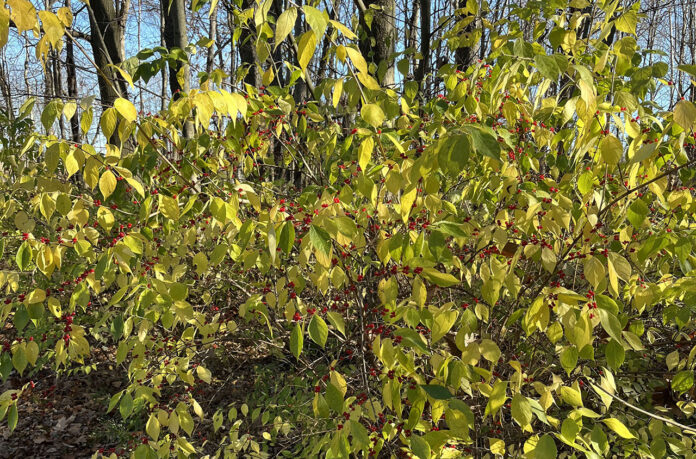
After a weekend of high winds, a walk in our woods looks very different now. The once bright leaves are now russet and amber in color, making crunching sounds under my boots.
Instead of a leaf canopy, the colors of early morning light can be seen beyond the branches of the barren trees. The only other bright color I can see is from honeysuckle bushes still holding onto their green leaves. Spanning the ravine, I can picture the seeds of the prolific plant spreading like wildfire before taking root in a new spot.
The berries of amur honeysuckle are like a sweet dessert for birds. They are high in sugar and other nutrients. Bluebirds, robins, and chickadees along with other birds feast on the berries and disperse the seeds.
Threatening
There are several different bush honeysuckle species in Ohio. Grouping them together, they are one of the most threatening invasive species in the state. The deciduous shrubs have long arching branches and can grow 6-20 feet tall.
The root system is surprisingly shallow. This makes it possible to easily pull young plants out of the ground, our chosen tactic. There are a few other options for eradicating bush honeysuckle. If there are not many plants, they can also be dug or cut. Even mowing down small trees is an option in early summer.
The goal of digging or pulling should be to get all the roots. The only way this is successful is if it is done frequently. More established plants are not as easily controlled.
Cutting a larger shrub honeysuckle at the base will just encourage sprouting and stem growth. Both the above-ground portion and the root system have to be controlled.
While we have not attempted it yet ourselves, the use of herbicides has been effective for controlling bush honeysuckle. Foliar spraying is when a diluted herbicide like glyphosate is sprayed directly on the leaves of the plant. Foliar spraying can be tricky because the spraying must be very targeted, only spraying the bush honeysuckle plant and not anything else surrounding it. Another concern with spraying is run-off.
A good time to spray bush honeysuckle is in the fall when surrounding native species are already dormant. Another option is applying herbicide to a cut stump. A bush honeysuckle plant that has been close to the ground can have an herbicide applied to the cut surfaces with a spray bottle, paintbrush, or roller. Water-soluble herbicides need to be applied immediately after cutting, but oil-soluble herbicides can be applied later.
This method is not recommended during sap flow in the spring. Late summer, fall, and dormant season applications are typically more successful.
How they got here
As with a lot of invasive species, I have to wonder how bush honeysuckle ended up in Ohio. Most invasive species have a similar story. Bush honeysuckle was brought to the U.S. from Asia to be used as an ornamental plant in city landscapes in the late 1800s.
It arrived in Ohio in the 1950s. It was thought that it would help stabilize the soil. Unfortunately, bush honeysuckle has proven over time that it can establish growth in a variety of landscapes including forests, meadows and prairies.
It begins to compete with native plants for nutrients. It tolerates moderate shade environments well by outcompeting neighboring plants for available sunlight.
As far as the plants in our woods, I know how they got there. Unfortunately, we planted them. Regret settles on my shoulders thicker than fog in a valley.
Years ago, bush honeysuckle plants were included in a group of saplings provided by our local Soil and Water Conservation District. I made the mistake many others have made. I assumed all honeysuckle plants were native.
Growing up, my parents had a major wheeler coral honeysuckle vine planted behind their house. In the abundant sunlight, it flourished, growing over 6 feet tall. It bloomed all summer and attracted hummingbirds and pollinators to the flowerbed.
Major wheeler honeysuckle is native to the eastern United States. Trumpet honeysuckles, like the major wheeler variety, are related to the invasive species of bush honeysuckle like amur honeysuckle and Japanese honeysuckle vine.
I am sure I am not alone in the backpedaling battle against bush honeysuckle. Slowly but surely, we are attempting to eliminate bush honeysuckle and other invasive species from our woods.
Moliere, a french playwright penned the quote, “the trees that are slow to grow bear the best fruit.” In this situation, it carries a double meaning in regards to our progress and native plants.












